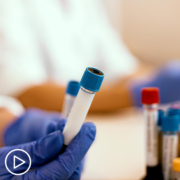Choosing an MPN Treatment: What Option Is Best for You? from Patient Empowerment Network on Vimeo.
When choosing an MPN treatment, what’s right for you? Dr. Brady Stein from Lurie Cancer Center reviews key decision-making factors, current treatments for ET, PV and MF, and shares advice on advocating for yourself.
Dr. Brady Stein is a hematologist focusing on myeloproliferative neoplasms (MPNs) at the Robert H. Lurie Comprehensive Cancer Center of Northwestern University. Learn more about Dr. Stein, here.
Download Program Resource Guide
Related Resources
Transcript:
Katherine:
Hello, and welcome to the webinar. I’m Katherine Banwell, your host for today’s program. Today, we’ll discuss how you can be proactive in your understanding of MPNs and work with your healthcare team to find the best MPN treatment path for you. Joining me today is Dr. Brady Stein. Thank you for joining us. Would you please introduce yourself?
Dr. Stein:
Hi, my name is Brady Stein. I’m a hematologist at Northwestern University in Chicago, and thanks very much for having me.
Katherine:
Before we begin, a reminder that this program is not a substitute for seeking medical advice. Please refer to your own healthcare team about what might be best for you. Dr. Stein, let’s start with the basics. The term “myeloproliferative neoplasms,” or MPNs, can be a bit confusing. Would you give us a brief overview of the classic types of MPNs?
Dr. Stein:
Sure. So, there’s three classical types of MPNs that we focus on. These are the BCR-ABL-negative MPNs. So, what we’re referring to in this webinar is essential thrombocythemia, otherwise known as ET, polycythemia vera, often referred to as PV, and myelofibrosis, often referred to as MF, and myelofibrosis can exist on its own.
It can be primary, so a patient can start with that diagnosis, but it’s also important to note that patients who have ET or PV for long periods of time – they can head in the direction of myelofibrosis, so that’s kind of a secondary type of myelofibrosis, sometimes referred to as post-ET MF or post-PV MF. So, those are the three basic subtypes that we’re gonna speak about today.
Katherine:
Do symptoms vary for each type – ET, PV, and MF?
Dr. Stein:
They do. They vary, but they can overlap. So, oftentimes, ET is thought of as the more indolent of the MPN subtypes, but I think it’s pretty clear that patients with ET can have a similar burden of symptoms compared to patients who have polycythemia vera and myelofibrosis, so they exist on a spectrum, I think most to a degree that symptoms can be the most pronounced in patients with myelofibrosis, but not to undermine the symptom burden that can occur in ET and polycythemia vera.
Katherine:
Once a patient is diagnosed with MPN, what sort of testing should take place?
Dr. Stein:
So, the test that’s gonna lead to suspicion is gonna be a blood count, and that’s probably gonna be done in the primary care doctor’s office, so that’s gonna be the first suspicious test, and in general, there’s gonna be some abnormality. Myeloproliferative diseases are characterized in general by an overproduction of blood cells, so it’s going to be a higher white count, it’s going to be a high hemoglobin or hematocrit, or a high platelet count, or a combination of the three that’s generally gonna lead to suspicion.
Some patients may have pretty unremarkable blood counts and may present with a blood clot in an unusual location that could ultimately lead to the hematology referral. Some patients might have pretty unremarkable blood counts, but they might have palpation of their spleen, enlargement of their spleen in a physical examination. So, they’re generally the ways that patients are getting to the hematologist.
Katherine:
And, what about bone marrow biopsy?
Dr. Stein:
So, a bone marrow biopsy is a diagnostic test, and it’s generally recommended for all patients who have a myeloproliferative neoplasm either confirmed or suspected.
It’s advised in WHO criteria – World Health Organization criteria. PV can be made without a bone marrow biopsy – a diagnosis of PV – because it’s the most unique of the MPN subtypes. It’s the one that presents with a high hemoglobin.
So, that diagnosis can be straightforward at times for a hematologist when the setting is right, when there’s a high hemoglobin – or, high enough hemoglobin, I should say, a JAK2 mutation, which all patients with PV have that, or a subnormal erythropoietin level.
Oftentimes, we can make that diagnosis without a bone marrow, and the bone marrow becomes more prognostic. ET, a bone marrow is necessary for diagnosis, and myelofibrosis, you can’t make a diagnosis without it.
Katherine:
What do the results of these tests tell us about prognosis and treatment choices?
Dr. Stein:
That’s a good question. The bone marrow can be diagnostic in the setting of ET and myelofibrosis. In the setting of polycythemia vera, it can be more prognostic. In general, when a bone marrow is done, 1). To confirm diagnosis, 2). To assess prognosis, what we’re looking for as prognostic features are generally the degree of fibrosis or scarring.
So, each of the MPNs can have that. Of course, MF is characterized by the most pronounced scarring. It can happen to a more subtle degree in ET and PV. That’s gonna be prognostic in the setting of ET or PV. The pathologist will alert us about immature cells called blasts. We basically never see them at diagnosis in patients with ET or PV. We can see them rise in patients with myelofibrosis at diagnosis or through the course of follow-up. So, that’s prognostic.
All bone marrows generally have a chromosome analysis that’s called cytogenetics, and so, if there’s an abnormality, that can help place the patient’s prognosis into different risk categories. And then, nowadays, more so in myelofibrosis than any of the others, there are extended panels done. These are called NGS, or next-generation sequencing, kind of looking at mutations in a greater degree of detail.
So, not just what we call main mutations – JAK2, calreticulin, or MPL. These are looking at additional mutations that basically hold prognostic significance.
These are pretty well defined, and I think more important in MF compared to the other subtypes.
Katherine:
Would you explain the driver mutations in MPNs? What are they, and how they – or, what they mean for patients?
Dr. Stein:
So, there’s three of what we call driver mutations, and the most common is JAK2V617F, the next most common is calreticulin, and the least common or most rare is a mutation of MPL, the thrombopoietin receptor. So, the driver gene mutations are the three that we assess to help with diagnosis, and the prevalence varies. In ET, about 60% have JAK2, 25% have calreticulin, 5-10% have MPL.
In PV, 99% have some type of JAK2 mutation, and in MF, the situation is a lot like ET – 60% JAK2, 25% calreticulin, about 5-10% MPL. So, the driver mutations – we think of those as the genetic abnormalities that really drive the disease. They’re the main ones we can test for in a diagnostic setting.
I refer to them as the – to a patient, what I’m describing is you have a car, and the driver mutation is the one that’s sort of driving the car, and it’s doing it somewhat recklessly. It’s in the front seat, driving. And, along the way, the driver can pick up hitchhikers, which we should never do. I refer to those other mutations that are found by NGS as hitchhiker mutations that sit in the back seat, cause trouble, and really shouldn’t be there. They’re not the driver, they’re not fully responsible for the disease, but they can make it a bit worse.
Katherine:
We have a question from the audience, Dr. Stein. “I was recently diagnosed with MF, and I’ve had a bone marrow biopsy. How often will I need to undergo this procedure?”
Dr. Stein:
That’s a really good question. It’s a very important, very common question. So, the first bone marrow biopsy is diagnostic. The second bone marrow biopsy – or third – are generally reactive, meaning we don’t schedule them year to year unless there’s a change. We do them in a reactive way. If there’s something about the condition that’s changing – for example, if we suspect or worry about a progression – that’s when we would do the second bone marrow biopsy. So, we don’t set a determined frequency if the condition or the course is stable.
Katherine:
Dr. Stein, I understand that therapy is different for each of the MPNs. What do you take into consideration to help guide the treatment choice?
Dr. Stein:
So, that’s a good question. It’s gonna require maybe a little bit of a longer answer. It’s fairly nuanced. The treatment of ET and PV – right now, the goals are – the treatment is largely based on a patient’s vascular risk. That’s largely what influences the choice of therapy. And so if a patient has a perceived high risk for vascular complication in ET or PV, that’s when we’re gonna be a little bit more aggressive – so, more aggressive than watchful waiting, more aggressive than using aspirin alone, more aggressive than using phlebotomy and aspirin alone in polycythemia vera.
So, if the patient has a higher vascular risk, in general, we’re gonna need to do something more than what we consider to be the standard, and that’s where we enter into the question of cytoreductive therapy – therapies designed to lower blood counts apart from phlebotomy.
Maybe that’s gonna change. I hope it will change. Right now, the therapy for ET and PV is generally reactive. We either predict high risk and react, or if a patient is lower risk, if something changes – God forbid there’s a blood clotting event – then we may react to it.
So, ET and PV treatment are generally more reactive. In myelofibrosis, certainly, there are patients who can have lower risk and minimal systems, and there are some patients who can be observed with watchful waiting for sure, but more patients are symptomatic, more patients are gonna need therapy in myelofibrosis, and there’s sort of two big categories of therapy.
One is the risk-adapted, deciding if the patient is eligible and should consider stem cell transplant versus thinking only about medical therapy in a patient that may be transplant-ineligible.
And, the medical therapy is based on the worst symptoms for the patient. Is the symptom that’s the worst the spleen enlargement? Is it excessive fatigue? Is it weight loss, or inflammation, or fevers? If it’s that category of symptoms, we have a set of therapies. If it’s really the anemia that is the most problematic issue, then we follow a paradigm to treat anemia.
Katherine:
What about considerations like the patient’s health, age, genetic markers, things like that?
Dr. Stein:
So, of course. The comorbid illnesses can influence therapy choices, so if a patient is older and has other medical conditions, they’re not gonna be treated as aggressively.
So, in myelofibrosis, if a patient is older, with other medical illnesses, then it may be inappropriate to consider something like stem cell transplant, for sure. So, age and health comorbidities are highly influential. In terms of genetic features, if you’re asking about things like the type of mutation that a patient has, right now, we’re – in terms of vascular risk, for ET, the type of mutation matters for blood clotting risk, so if patients have different mutations, it could be treated differently. In other subtypes, like PV or myelofibrosis, in general, there’s – the mutation can be prognostic, but it may not be – it may not lead to a precise and distinct therapy just yet.
Katherine:
All right. What do you feel is the patient’s role in the decision for therapy?
Dr. Stein:
I think it’s a really important role. I think historically – and, this is decades past; this era should be well over and behind us – this era of authoritative medicine is over.
You can’t just have a doctor walk in the room and say, “This is your treatment, this is what you should do, I’ll see you later.” It’s shared decision-making, and that can be troubling for some patients. But, the idea of shared decision-making is us explaining options informing the patient and making decisions together. That’s really the paradigm for modern contemporary medicine.
Some patients have a harder time with that. A lot of patients say, “Well, doc, this is too overwhelming for me. I just want you to decide for me.” And, we try not to do that. That’s a more uncomfortable type of visit for me when a patient is very deferential and says, “Whatever you say, I’ll do.” That’s not really what we wanna hear. I wanna know that you feel really informed, that you have a good understanding because each of these treatments – any treatment, any medication has its pros and cons.
There’s no real magic bullets, and each upside has an equal downside, so you have to engage and open a dialogue, and what that means is that patients need to read and learn. That’s hard, but patients need to become proactive in their approach to their own illness, and all the patients who are listening now are doing that, trying to get more education about your relatively rare illness that’s gonna give you a much better framework to help make decisions together.
Katherine:
Absolutely. If a patient isn’t feeling confident with their treatment plan or their care, do you recommend that they maybe consider a second opinion or seek a specialist?
Dr. Stein:
Of course, yeah. These are rare diseases, and patients often – I would say that in my clinic, a lot of the patients direct their own second opinions. Oftentimes, it’s coming from the patient more so than their doctor. I think the patient community is very active, the patients are networking, and they’re finding the right specialist to get to.
I think it should be really a team approach. It’s never – it’s usually not very convenient to go to a university unless you live really close, so you wanna have someone close to home who can handle the routine, and then, someone who maybe is a little bit further away who can see you once a year, can help with the big decisions, can be part of the healthcare team. So, we generally recommend that you have someone near, and that maybe you have someone far who focuses only on MPNs as part of your team, and now, it’s a little different. Telemedicine is becoming a pretty ingrained part of medicine. It’s a little easier to have those visits with a physician who’s far away because of telemedicine.
Katherine:
So, now that we’ve discussed how a treatment path is determined, can you walk us through the currently available MPN treatment approaches and who they might be right for?
Let’s start with essential thrombocythemia, or ET.
Dr. Stein:
So, I think the first thing is taking an inventory of symptoms, seeing how symptomatic the patient might be. Again, there are some patients who are asymptomatic or have few symptoms, and they were told of a high platelet count during a routine visit, so some patients can be observed if they have few symptoms, and especially if they fall into a lower vascular risk category.
So, symptom assessment first. Second, looking at vascular risk, and there’s four categories of risk in in ET in terms of predicting the likelihood of a future blood clotting event. There’s a very low, low, intermediate and high risk group, and that’s based on a patient’s age, whether they’ve had a blood clot before, and the type of mutation they have. JAK2 mutations increase the risk of clotting.
So, if a patient falls into a higher-risk group – say they’re older than 60 with a JAK2 mutation or they’ve had a prior blood clot – those are patients who are generally treated more aggressively with cytoreduction. And then, the other thing is aspirin. We often see aspirin given to all patients with ET, but not all patients with ET necessarily need it. The role of aspirin is actually a little less clear in ET. For a very low-risk patient, there’s a potential for more harm than benefit, especially if the patient lacks a JAK2 mutation. So, the evidence base to support aspirin for all ET patients is just not there; it’s evolving.
Katherine:
What about polycythemia vera, or PV?
Dr. Stein:
So, there’s a few standards. It’s different – the aspirin question in PV is generally answered by randomized data from 16 years ago in 2004. It’s been shown that aspirin reduces the risk of clotting in PV patients, so, generally, we give low-dose aspirin to all patients.
And, hematocrit control is really important. At least, a goal of 45% is mandated in PV. And then, there are patients who might fall into a higher-risk category – older than 60 or have had a prior blood clot – they need something more. And then, I’d also emphasize that there are lower-risk patients who may not be traditional candidates for cytoreduction, but they could have symptoms that really interfere with quality of life, and symptoms alone can be the trigger to add something more to the phlebotomy and aspirin program.
Katherine:
What about things like interferon?
Dr. Stein:
So, interferons have been used in MPNs for decades and decades. So, a longstanding history with interferons. The issue has been tolerability.
These days, there’s a class called pegylated interferon that’s longer acting, and I think there’s been a lot more use, at least in the last 10 years, still much more in an academic setting than a community practice.
But, interferons have a pretty established role in MPNs, especially polycythemia vera, for sure in ET, less so in myelofibrosis.
Katherine:
Dr. Stein, you mentioned high-risk versus low-risk patients quite a bit. How is that risk determined?
Dr. Stein:
So, it’s different for each subtype. For ET and PV, when we talk about high versus low risk, we’re talking about vascular complications, risk of having a blood clot. We’re not really talking about risk of transformation. We don’t have, I think, wonderful, widely used toolkits to predict those things. We know they can happen, but our treatment is still really based on clotting for ET and PV.
And, MF – each couple of years, the tools that are available to assess prognosis become more and more. So, in MF, we’re using the most comprehensive approach – of course, taking into account things like age and demographics, but also, looking at symptoms, looking at the depth and severity of blood count changes, looking at bone marrow features like the degree of scarring, looking at the rise in blast counts, and then, looking at chromosomes and novel genetic markers. So, we’re definitely the most comprehensive in myelofibrosis at assessing prognosis.
Katherine:
How do clinical trials fit into treatment choices?
Dr. Stein:
Clinical trials are always a treatment – always an option for patients with myeloproliferative neoplasms because while we have some standards, we can definitely improve upon those standards for certain. So, clinical trials are always a therapeutic option. I think the one thing is that it may not – it’s not always the most convenient option, but it could be a really important option if available to you.
So, clinical trials basically offer something new or novel that would not otherwise be available to other patients. So, ruxolitinib was approved around 2011, but the first clinical trials were in 2007, so that’s the example I give to a patient about the benefit of a clinical trial.
The patient can get access to a drug that’s effective perhaps three to four years before it’s commercially available.
That’s really the biggest advantage, is you can get early access to something that could really help you. The downsides are that clinical trials are not usually as convenient as regular care, there’s often more visits, and there’s a lot of unknowns – unknowns about whether it will work. Some side effects are known and expected; there are others that are unknown. So, it’s a lot to think about, but I think it’s always important to consider, especially if your first-line therapy has not been effective, if it’s losing its touch, it’s a good thing to think about for a second line.
Katherine:
Are there emerging approaches for treating MPNs that patients should know about?
Dr. Stein:
Yeah, absolutely. I think the first question – I think patients are often worried that they have a really rare disease, and why would anyone do research in this area, and that’s – the research community is extremely engaged, the productivity is pretty impressive, and there’s a lot of clinical trials in the space, and I think what I try to explain is pharmaceutical companies aren’t just targeting the most common diseases.
They have interests in rare diseases, and findings in rare diseases can be extrapolated to other diseases that you might think are unrelated, but they can share features, so when you find something working in one space, it can have broad applicability. So, there’s an abundance of research in myeloproliferative neoplasms which are emerging?
In PV, I think there’s quite a possibility that there’ll be a drug approval in 2021, a novel type of interferon called ropeginterferon.
That is a drug that’s approved abroad; it’s approved in Europe, and I believe it’s approved in Taiwan, and the FDA is looking at it now. So, it’s a possibility that there’ll be a future option for patients with polycythemia vera. So, yes, it’s research now, but it could be available, and so, that’s the drug that I’m starting to talk more and more about for patients with PV.
In myelofibrosis, you have two JAK inhibitors that are approved, ruxolitinib and fedratinib, you have two others in clinical testing, momelotinib and pacritinib, and then you have a whole other class of what we call non-JAK2 type of therapies targeting the vast array of pathway abnormalities in myelofibrosis.
So, there’s a number of different clinical trial options, especially in myelofibrosis. I think that’s the disease area where there’s the most clinical trials.
Katherine:
Once a patient has started treatment, how do you know it’s working?
Dr. Stein:
That’s a good question because this is a very unique area. Yes, of course, in some respects, it’s straightforward with ET or PV. If we’re starting a medication to control a blood count in hopes of having lowered the thrombosis risk, you can look objectively at blood counts.
Okay, your hematocrit is at this goal? Yes, therapy’s working. You have not had a blood clot? Yes, therapy’s working. So, there are some objective things. In myelofibrosis, there are some objective things like measuring the spleen and seeing it reduce. You can feel that with your hands, or you can do an ultrasound. So, there are some objective parameters of success. But, in this area, patient-reported outcomes are really important, and so, a measure of success is really just asking the patient, “Do you feel like your drug is working? Do you feel better?”
It’s kind of a simple question, but it’s really important, and it’s what we ask in patients who are on certain therapies. “Do you feel like the net effect of your therapy is still positive? Do you feel like it’s helping?” Seems like a straightforward type of question, but I think the answer is extremely informative. When a patient says, “Yes, definitely, my medication is still helping me,” then I know that I don’t need to change it.
Katherine:
Right. Patients are often concerned about progression in MPNs. Would you explain the progression of MPN and the indicators that one might be progressing?
Dr. Stein:
So, I think the important but hard thing to know about MPNs is that they’re chronic progressive illnesses, but what we don’t know in an individual is how long it’ll take to progress. Is the ET or PV gonna progress in 10 years, 25 years, or 35 years? Those are difficult things to predict. And, MF is progressive as well. I think it’s a little easier to identify those patients who may progress more rapidly compared to more slowly.
So, MPNs progress, and that’s the first important thing, is that they’re chronic illnesses and patients have to be aware that they can change. ET and PV can move to myelofibrosis, and when that happens, generally, symptoms change, the spleen enlarges, and blood counts change. We start to see anemia when we didn’t before.
And, when MF progresses, the symptom burden is one thing, maybe more fatigue, unexplained fevers, drenching sweats, or weight loss. On exam, measuring the spleen and seeing it get larger, seeing a fall in the platelet count, a need for red cell transfusions or a rise in the blast count. Those are all features that we’re looking for that can indicate a progression.
Katherine:
Let’s talk about patient self-advocacy now, Dr. Stein. Patients can sometimes feel like they’re bothering their healthcare team with their comments and questions.
Why is it important for patients to speak up when it comes to symptoms and side effects?
Dr. Stein:
I smile a little bit because patients – I get a lot of patient emails by MyChart. That’s our medical record, and it’s a secure patient email, and a lot of patients will start their message by saying, “I’m sorry to bother you.”
And, I always say, “Why do you think that? It’s my job. Please don’t apologize for reaching out to me.” So, that’s kind of the first thing. Don’t feel like you’re bothering your doctor. There are certain things that we won’t know unless you tell us, and so, I think that’s pretty clear. When we’re in a patient room and there might be a husband and wife together, and whether it’s the husband is the patient or the wife is the patient, we might ask a question, and we might get, “No, everything is fine,” but all doctors kind of sneak over to the partner, and the partner may be saying – they’re making gestures to us. There may be nonverbal forms of communication to tell us there’s something much worse than what the patient is telling you.
So, again, “advocate” meaning you have to tell us what’s going on with you. If you’re worried about something, please don’t be stoic about it. These diseases are treated a lot based on your symptoms, and so, if you don’t tell uls about your symptoms, we won’t know.
And, in terms of advocacy, I think one of the things is that these are pretty rare diseases. In an academic center, no, this is our focus, but if you’re in a community practice where the doctor’s seeing 10-15 different things during the course of a day, it’s basically impossible to keep up with myelofibrosis, especially if you have one patient in your whole practice. I can’t do that for diseases that I see that I have only one patient. The medical literature can be overwhelming.
So, patients can quickly outpace their doctor in terms of their knowledge of these diseases, but I think it’s really important to read, to learn, and to think about the illness because you may find out things through your research that your doctor wouldn’t know are available. You may find a clinical trial, a new strategy, or a new test that they simply haven’t had the time to keep up with or learn about. So, that’s what advocacy is about. Reading is really important, but you have to find a balance. I want my patients reading, but you’ve gotta find the right amount because there’s a certain amount of reading where the patients start to get overwhelmed.
All patients kind of get to this point. They take it in – like taking it in like a fire hydrant in the beginning of the disease, and it’s overwhelming, and then they start to find their balance. I think there’s a point where the reading becomes anxiety-provoking rather than ameliorating anxiety, and all patients just generally find their balance.
What I also say is if you read something that alarms you, write to me, write to us, and let us verify that because there’s a lot out there, and I think the patient communities are a phenomenal form of support, but there’s a lot of patients giving advice to each other, and sometimes that needs to be double-check – or, always, it needs to be double-checked by another doctor because sometimes, the advice is simply not – may be very individualized or not generalizable, or sometimes it’s simply inaccurate.
Katherine:
What would you like to leave the audience with? Are you hopeful?
Dr. Stein:
Oh, of course. Of course, I’m hopeful. What I leave the audience with is that things are changing; things are changing for the better, and the therapeutic choices in three years could be entirely different. I think there’s progress. Progress in medicine – some patients feel it, it’s slow, but having been in this field for a decade, there’s more and more therapeutic options emerging. Kind of what I’m looking to see most, honestly – I’m following everything really closely, but what I’m starting to think about more is paradigm shifts.
What I’d like to see in the field is to move away from a reactive type of approach and think more about early initiations of therapy, more of a proactive type of strategy, not really – because when we talk about therapeutic choices with a patient and the patient says to us – we don’t say it like this, but the way they say it back to us is, “So, wait, we’re gonna wait for something bad to happen, and then we’ll start treatment?”
I think that – I share discomfort, as – I’m uncomfortable with that approach. The reason we haven’t been proactive is because we’re kind of waiting for highly safe, highly effective therapies that could potentially change the course of the illness. That’s why we have been reserving our therapies, and that’s why our secrets sometimes include less aggressive watchful waiting with later initiation of therapy just because physicians haven’t been satisfied with their choices, but I’m hopeful that that’ll change.
Katherine:
Dr. Stein, thank you for joining us today.
Dr. Stein:
Thank you very much for having me.
Katherine:
And, thank you to all of our partners. To learn more about MPNs and to access tools to help you become a proactive patient, visit powerfulpatients.org. I’m Katherine Banwell. Thanks for joining us.






















